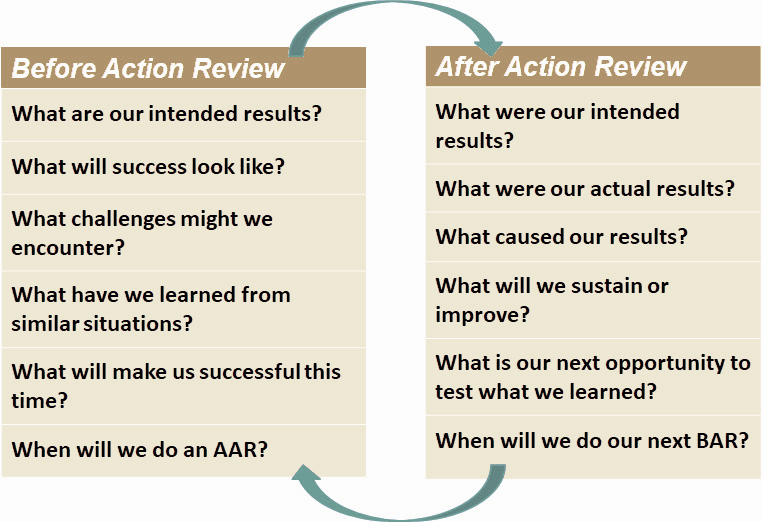What are Before and After Action Reviews?
The Before Action Review (BAR) and After Action Review (AAR) are simple, straightforward sets of questions to ask before and after an important piece of work — whether it is preparing for a meeting, engaging with board members or launching into a new initiative. While deceptively simple, these specific questions can have a profound impact on a group’s results. They help a group of people who together are responsible for succeeding at a piece of work to create a shared vision of what success would look like and strengthen their collective thinking to improve their ability to achieve results that matter.

You can think of a BAR and an AAR as “bookends” to a piece of action. Together, BARs and AARs use real work to build a group’s capacity to improve performance by comparing actual results with those intended, exploring the causes of those results, and applying the insights to the next opportunity to act. This practice, used repeatedly, improves a team’s ability to predict and address challenges in constantly changing environments.
The primary purpose of the BAR is to make sure that everyone in a group shares the same understanding of what we are trying to accomplish and how we would recognize success, and that everyone is actively thinking about how to achieve that — predicting challenges and drawing on past lessons and good ideas.
A BAR is different from planning. It’s more like a sports team huddling before a play. It takes the plan on paper and asks, “so what is it really going to take to make this work?” And, like a sports huddle, it makes sure that everyone who has a role to play in making it a success is involved in thinking it through together.
The primary purpose of the AAR is to help a group consciously test and refine its thinking and actions in real-time, using actual results as a guide, while there is still time to correct course and improve the outcomes of a project or initiative.
The AAR asks a team to reflect honestly on their actual results compared to what they intended to achieve, and to talk, equally honestly, about what contributed to those results — both good news and bad news, so they can do better next time.
When would we use a BAR or an AAR?
Because they are so simple, you can hold a BAR or an AAR around any piece of action, at any level, in just 30 minutes, with very little preparation.
Do a BAR anytime you are about to do something as a team that matters, and you are not certain of your results. Do an AAR anytime you feel that you have something to learn from what just happened — whether it was a big victory or a disappointing result.
BARs and AARs are most powerful when done repeatedly around small, but important, pieces of work – strategy decisions, convenings, regular program activities, etc. Keeping BARs and AARs short and simple makes them fit-for-purpose. If the meeting or preparing for it becomes too burdensome, a group may experience one great AAR but resist committing to doing them on a regular basis.
Because they are so simple, BARs and AARs can be used across a network of partners working together on a shared goal. Having this practice in common gives everyone a shared learning language and sensibility.
The Basics: How to participate in a BAR or AAR conversation
Come to a BAR realizing that, regardless of your ‘seniority,’ everyone can play a role in creating success. If you are being asked to do something and you don’t understand why, ask about the larger intent: “Help me understand how this will help us get to our larger goal.” When the group starts to think about what might go wrong (potential challenges), even if you are new to this particular team, you might have had an experience that could help all of you anticipate and prepare for an important challenge.
Come to an AAR with an open mind and heart. The AAR will ask a group to compare its actual results to its expected results. In the course of reflecting, a group is likely to discover small wins inside of a larger failure and, equally, small mistakes inside of a big win. The more willing you are to reflect honestly on your results and what might have contributed to them, the faster all of you can learn together.
If you are seen as a leader in this system, be the first person to speak up and say “here’s something I wish I had done differently.” That act of courage can make an immeasurable contribution to the whole team’s willingness to do this kind of learning.
And recognize that you won’t get it right the first time. As the commander of a unit of soldiers that created the AAR once told us: “Don’t expect a right answer from a single AAR. Most of what you identify in a single AAR is the wrong answers. It’s a complex task. So you go out and choose a different answer to the problem, and it’s wrong too, but maybe it’s less wrong. You’ve got to…take small bites, lots of them, over time, and they’ll work, eventually, to a complete solution to the problem.”